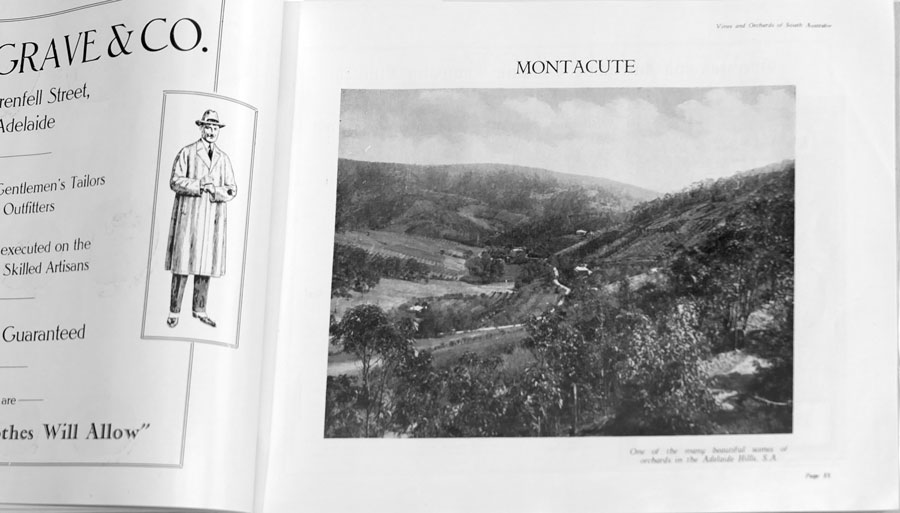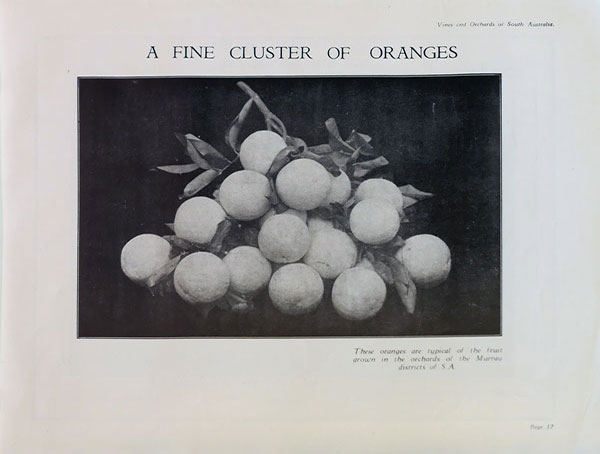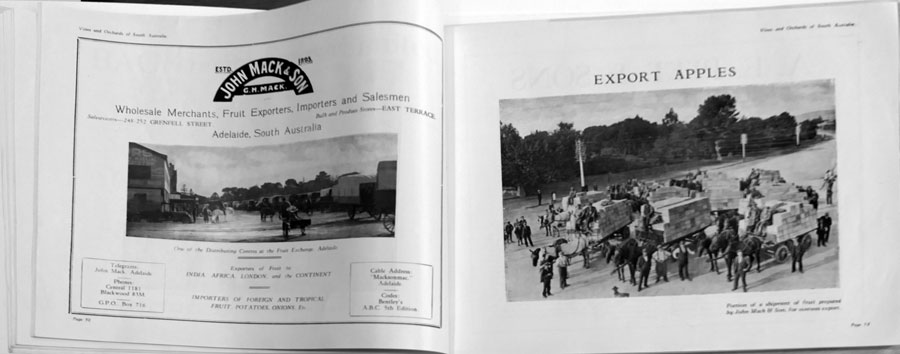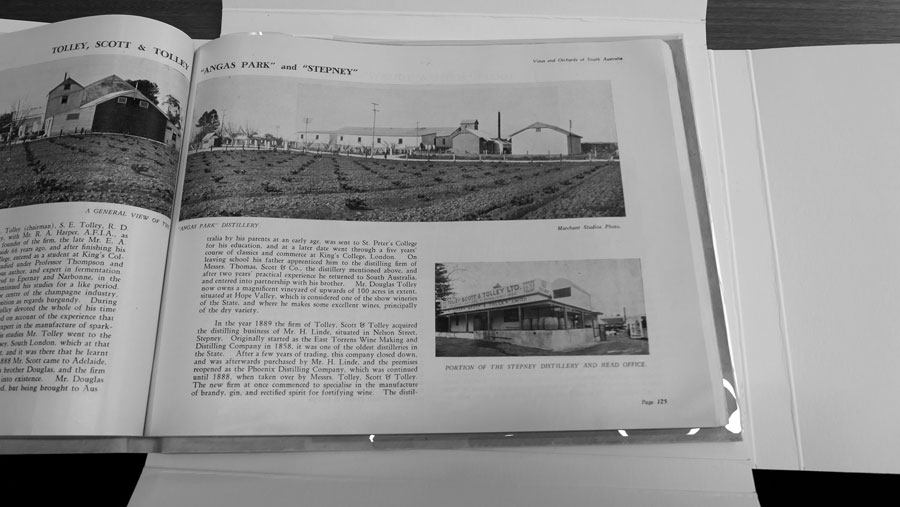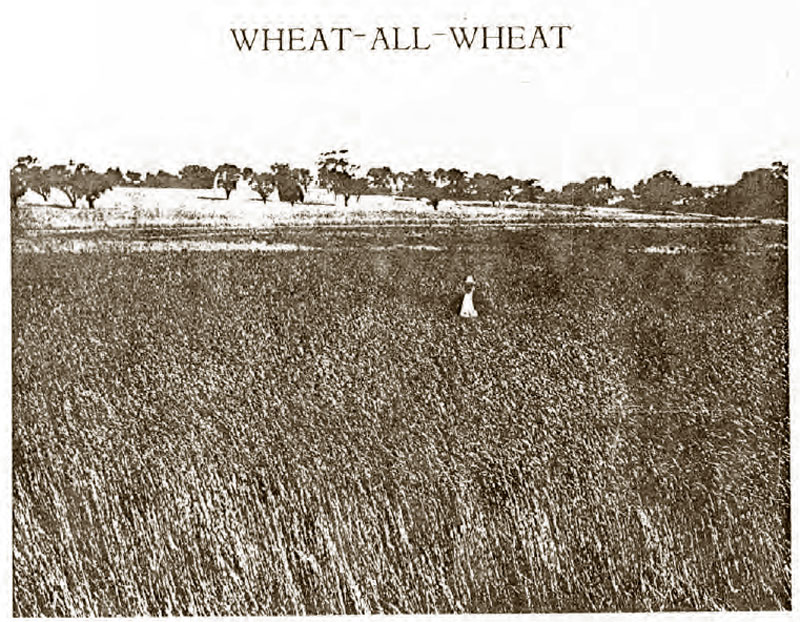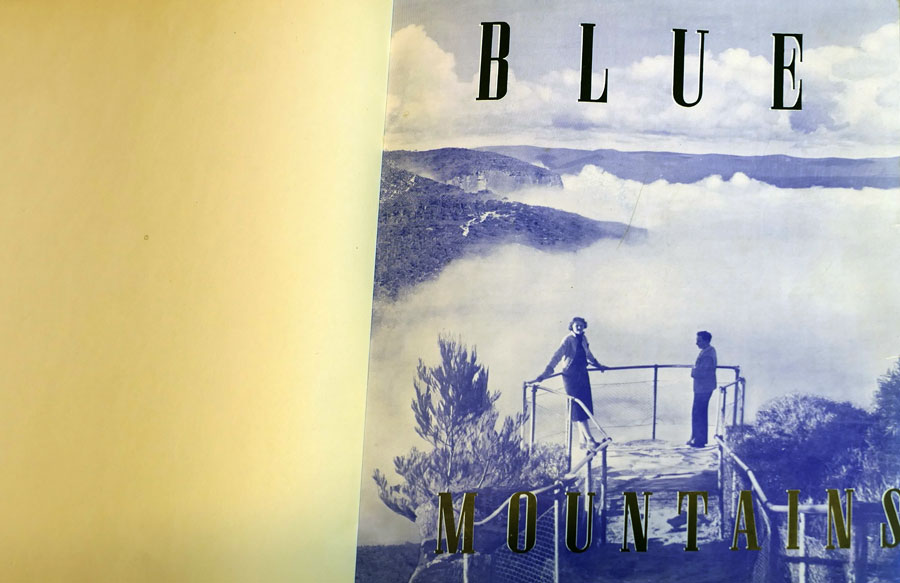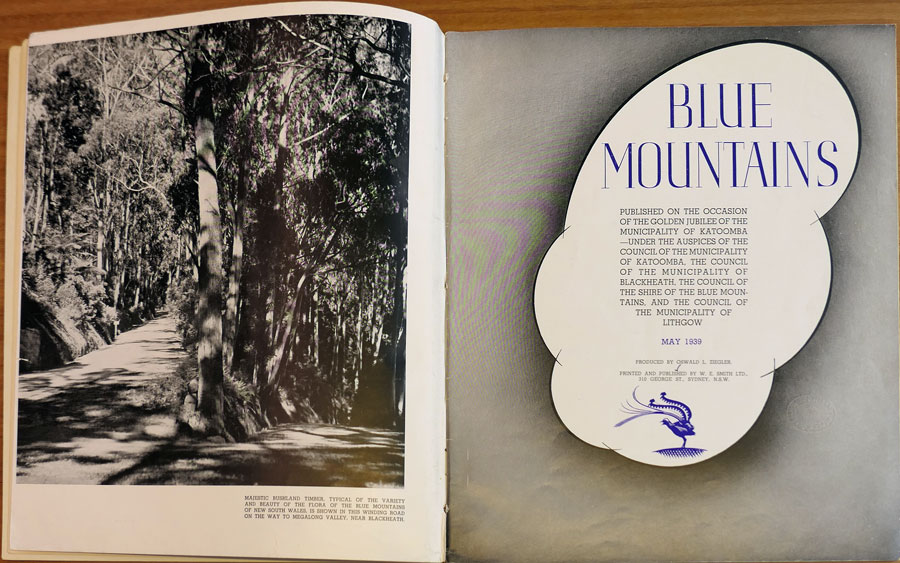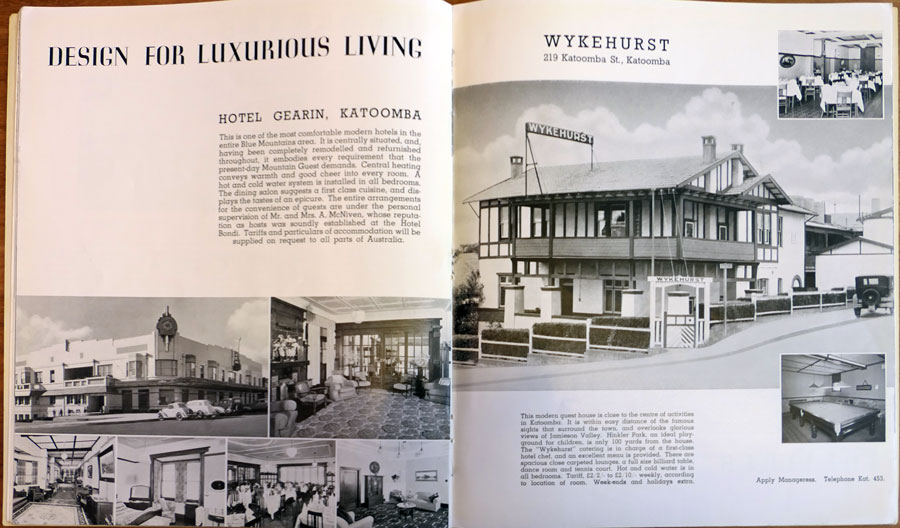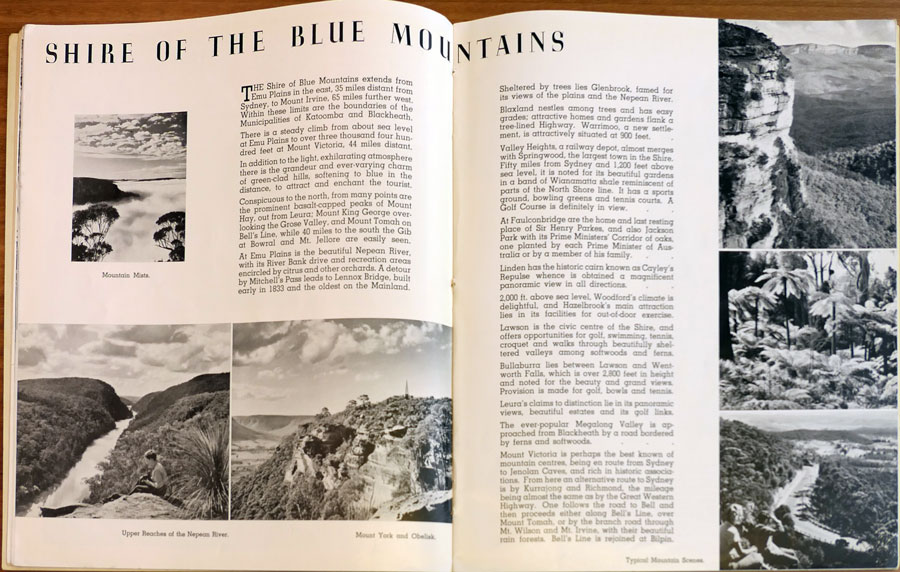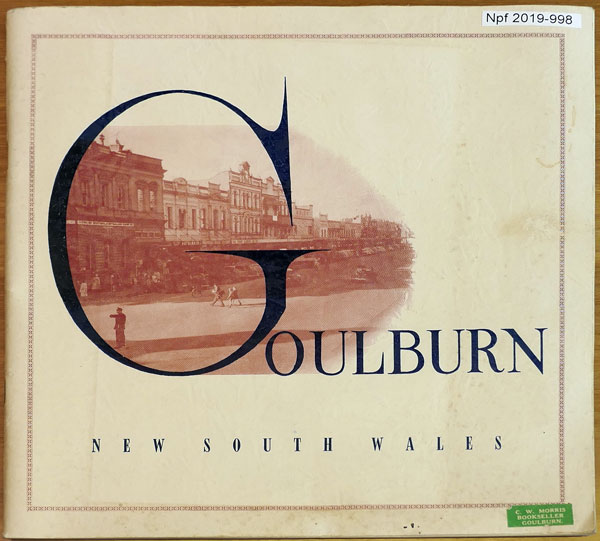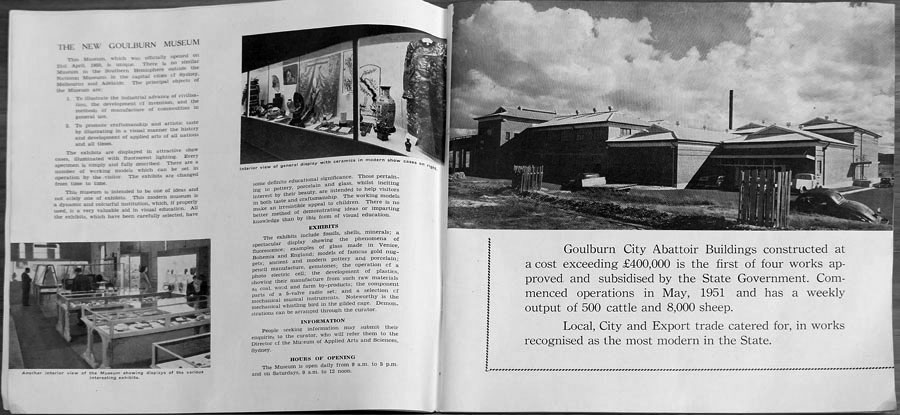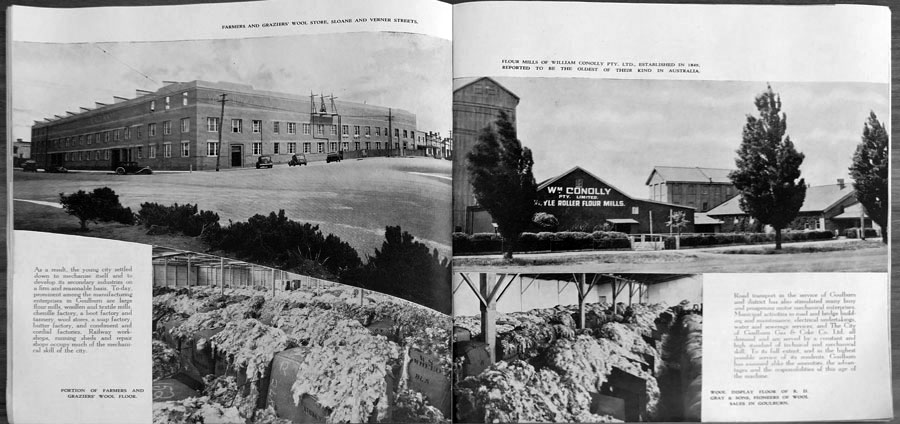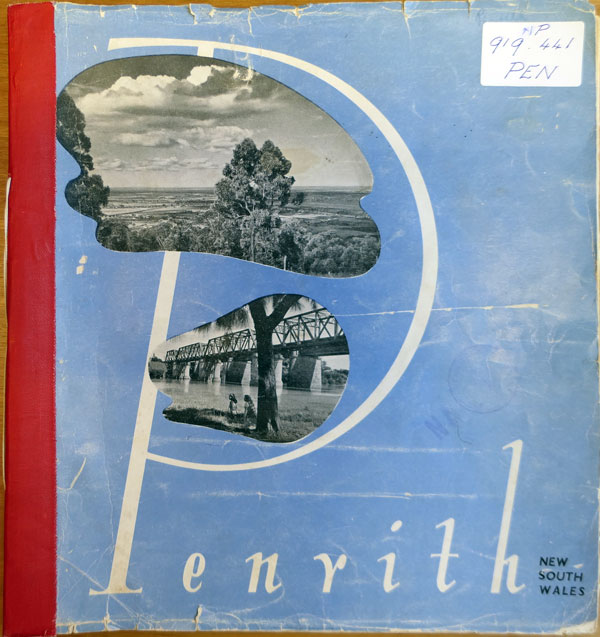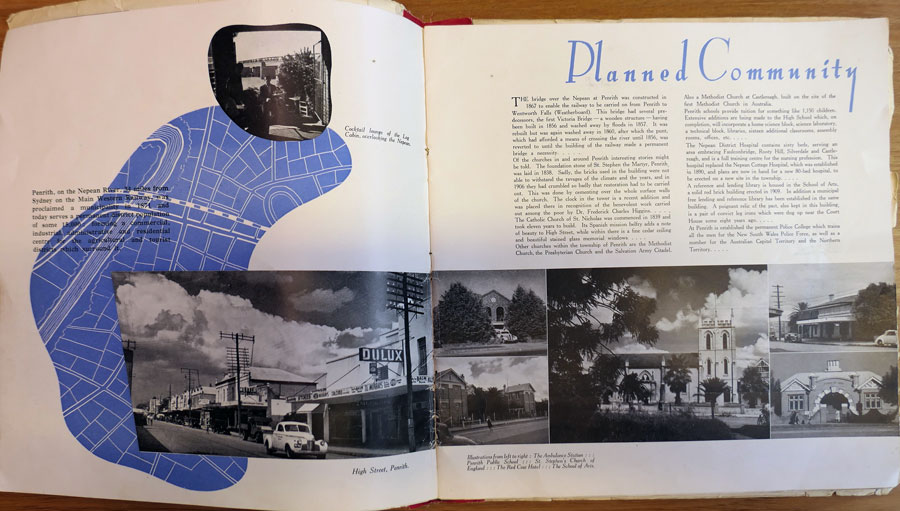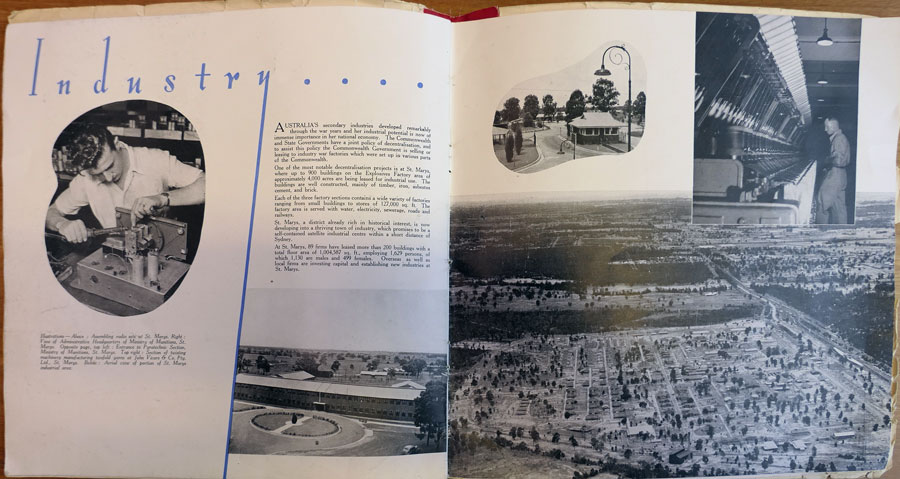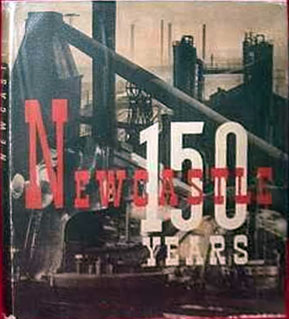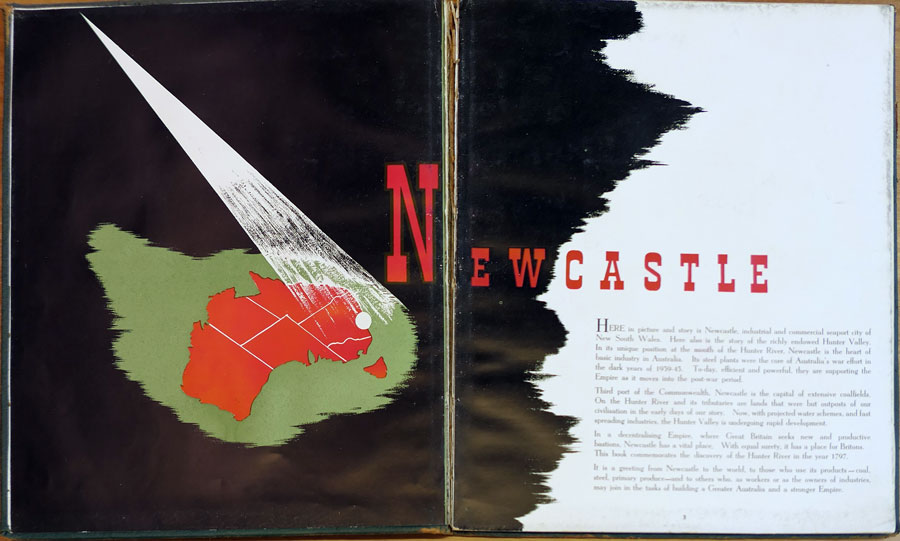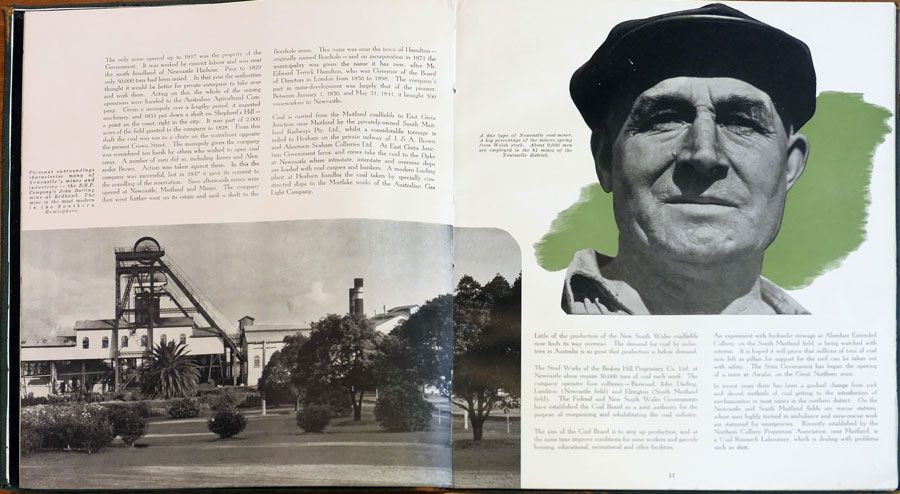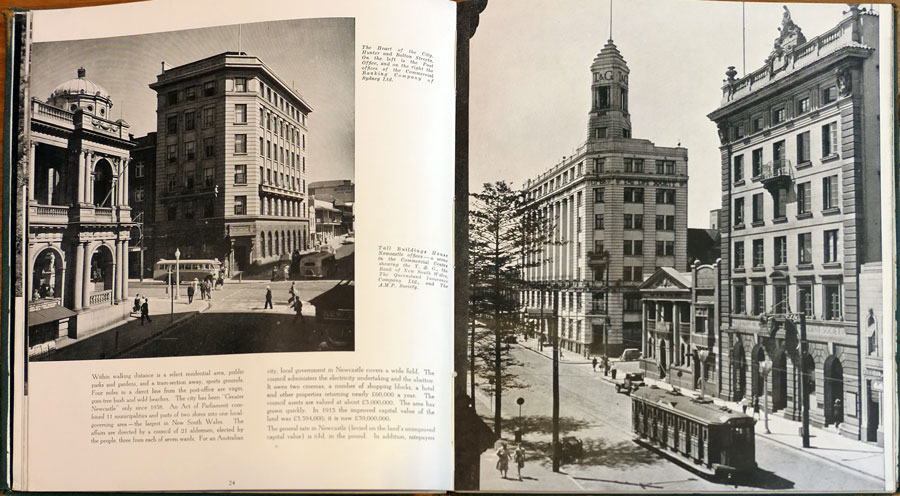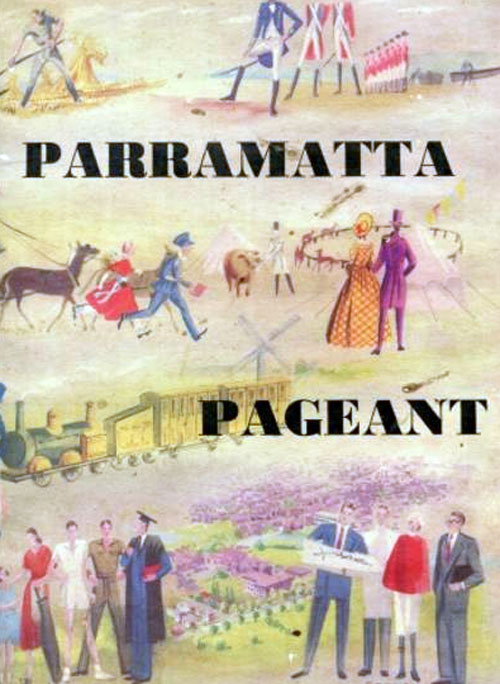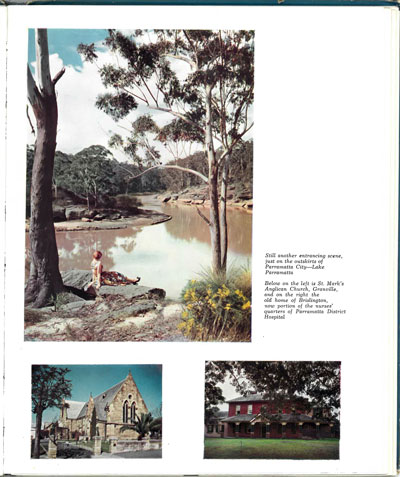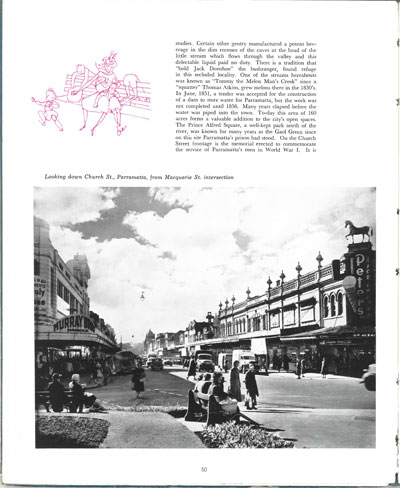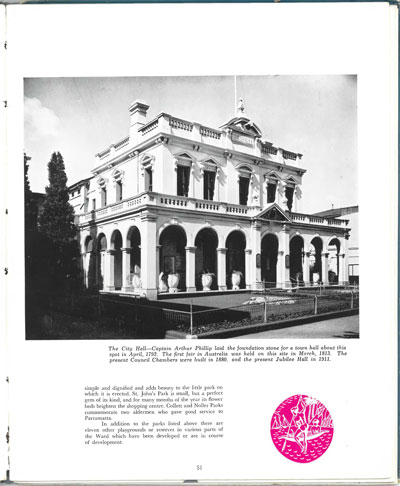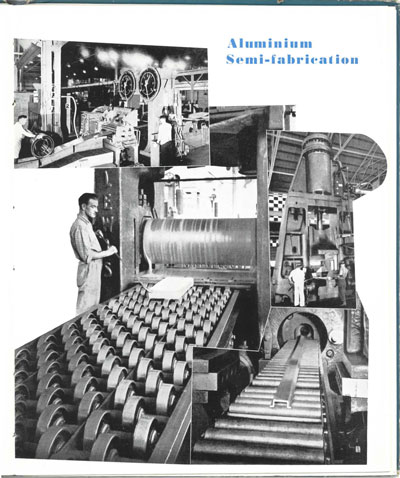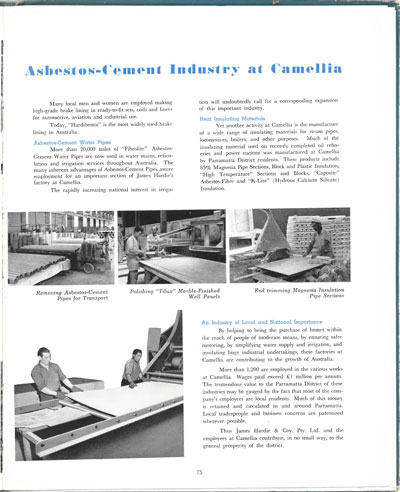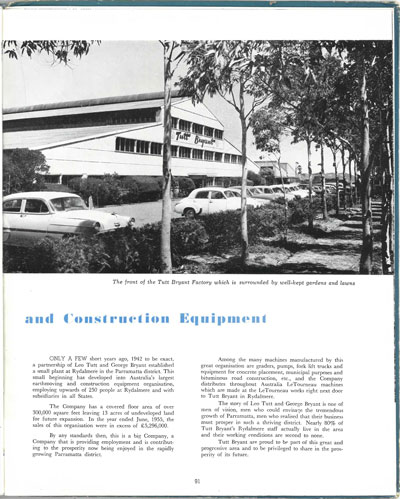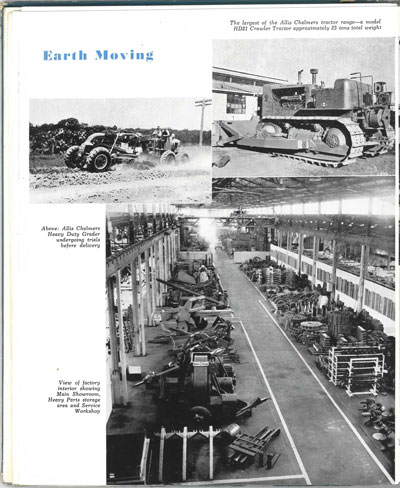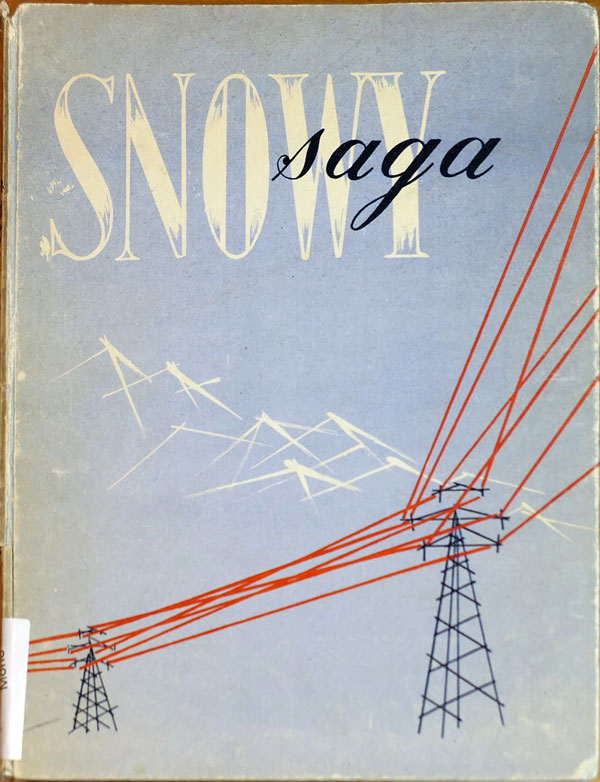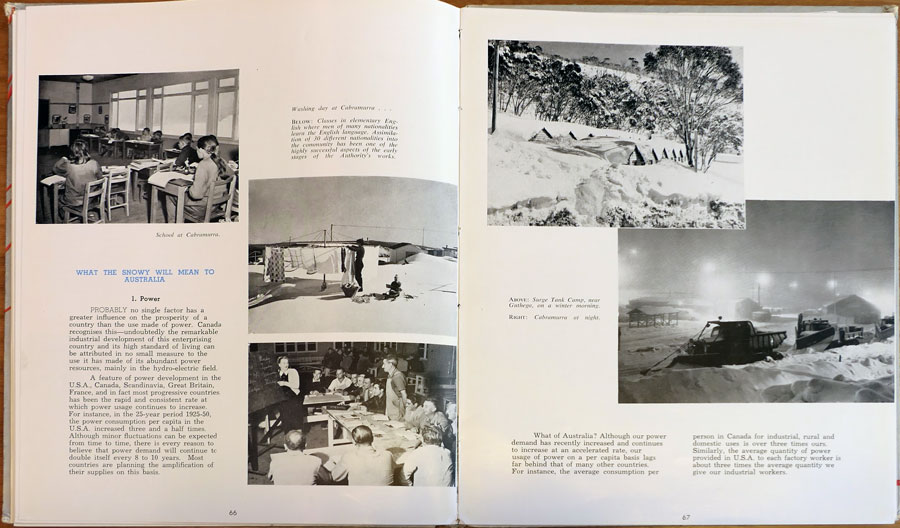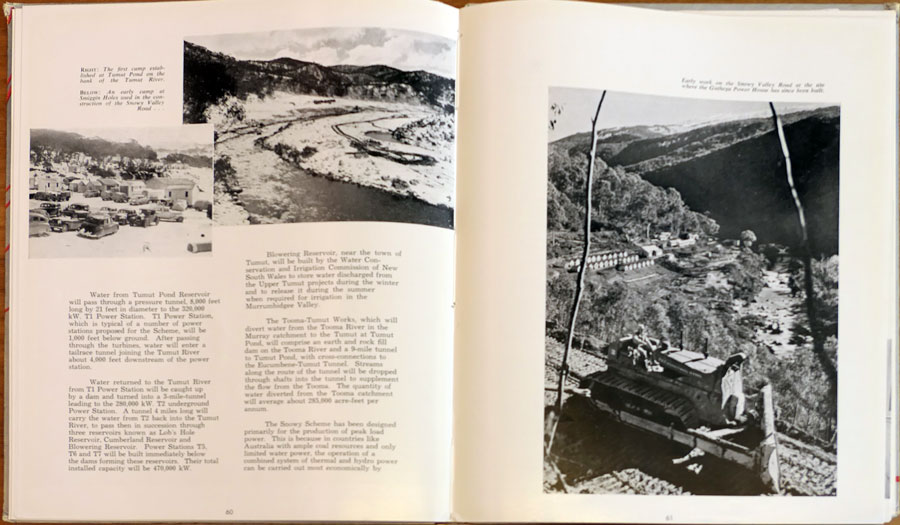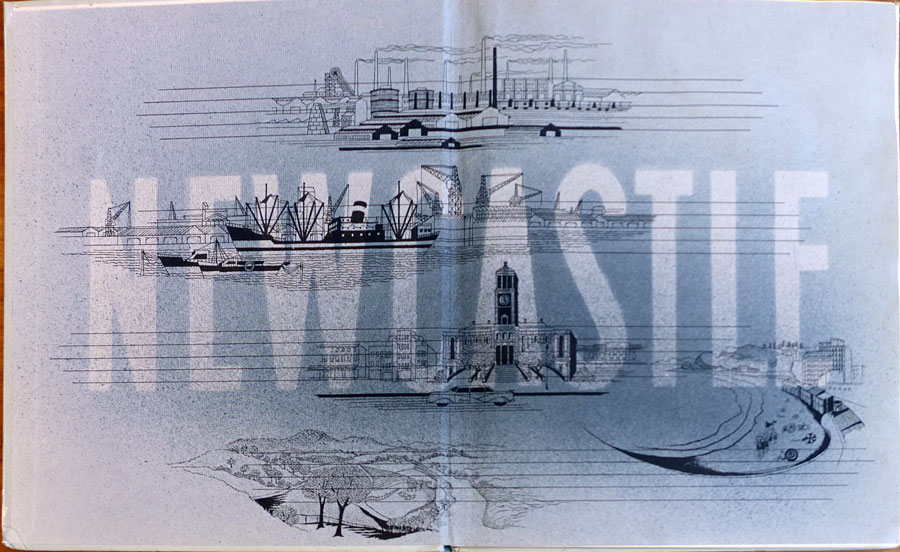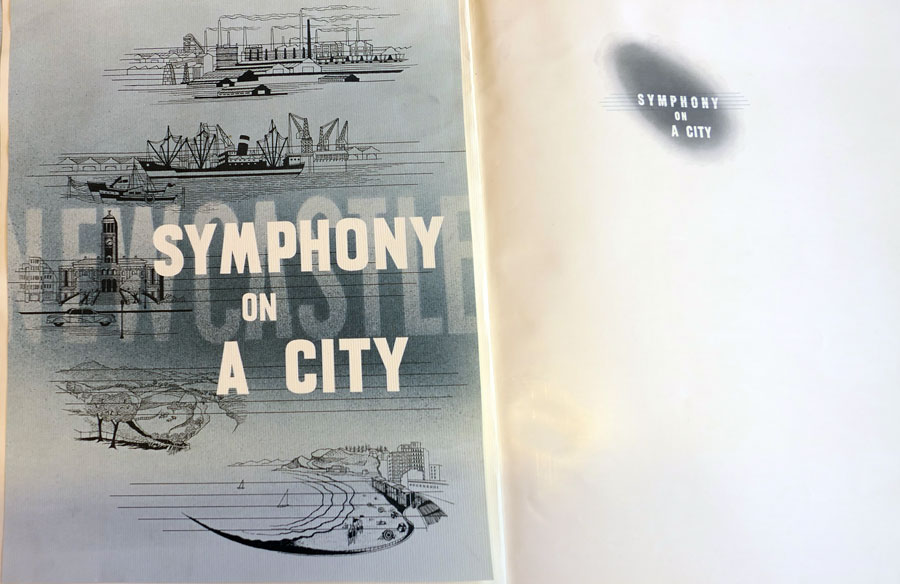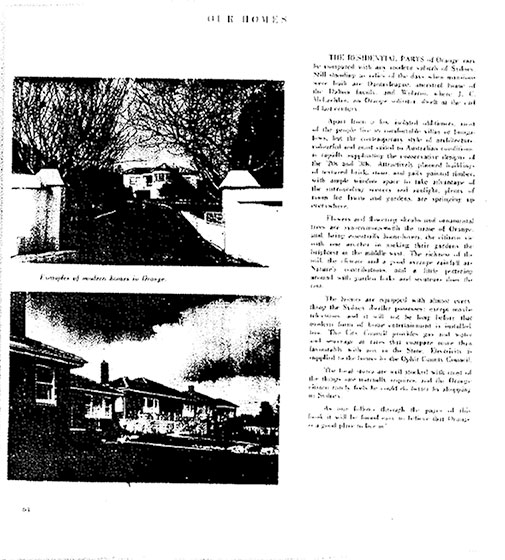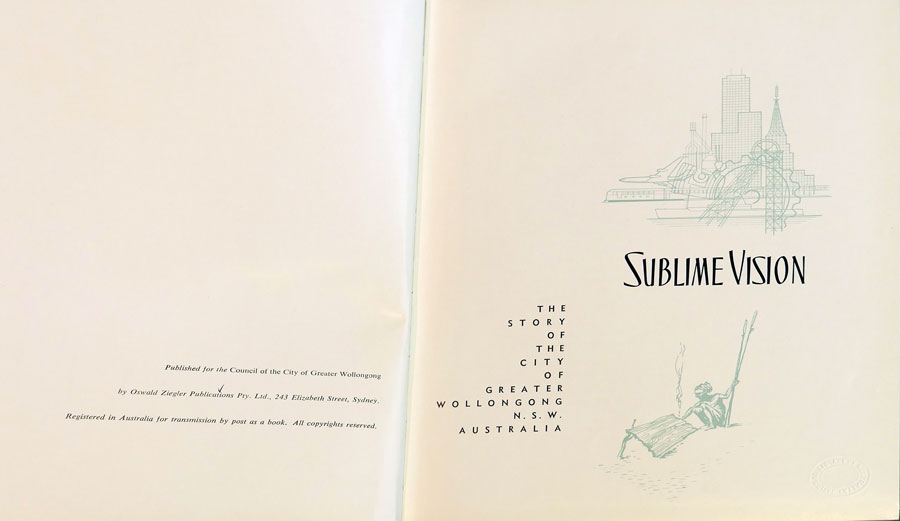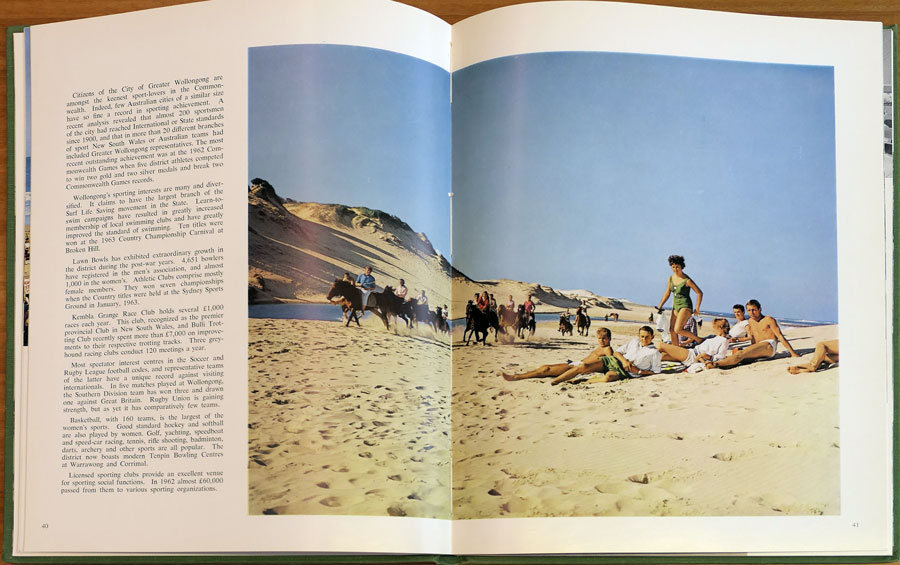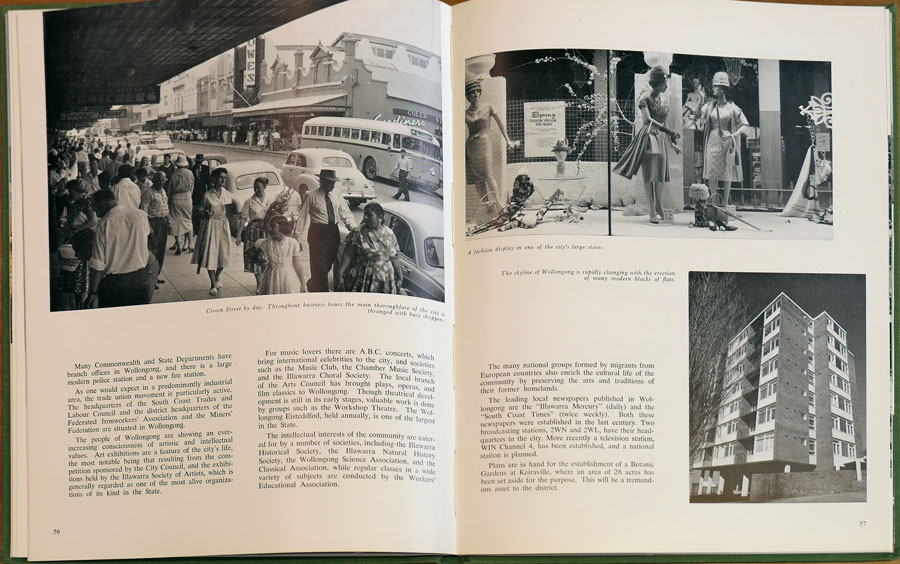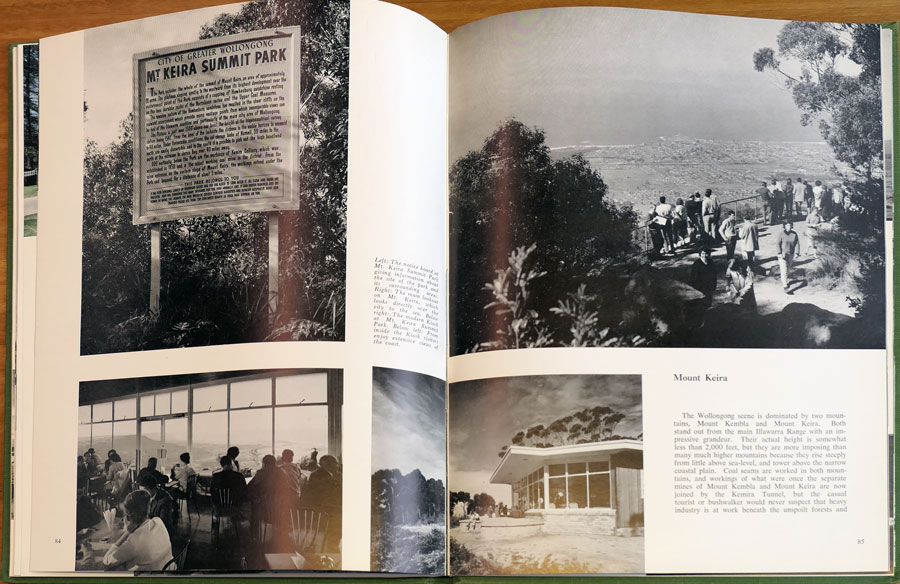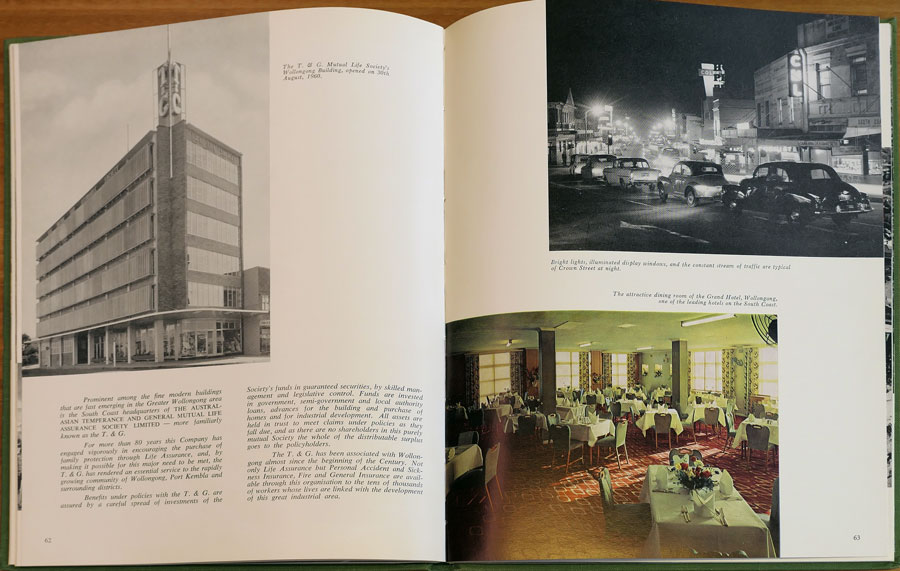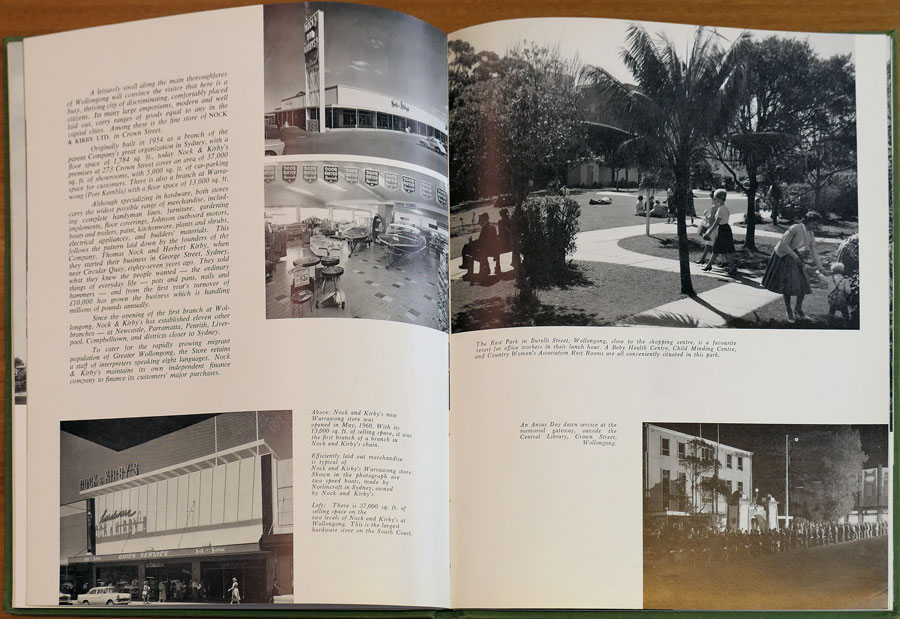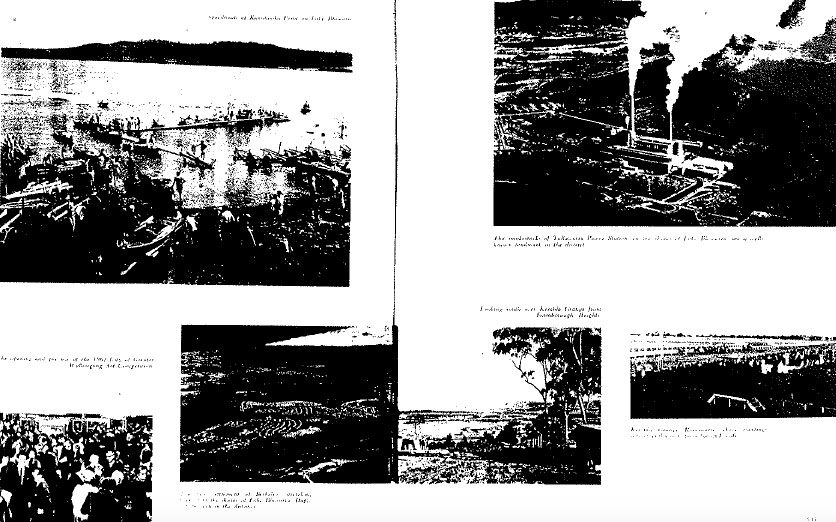When Oswald Ziegler followed his father into the production of illustrated advertising brochures for rural South Australia in 1928, he did so with pictorial reviews of large properties and townships in the area being covered. Review of the Lower North of South Australia… The Land of the Golden Grain promoted such holdings in the area northwest of Salisbury (now part of the satellite city of Elizabeth). As well as stock, homesteads and main streets, the pictorial content included some general, full-page photographs of scenery and agriculture.
After a brief period based in Melbourne for Victoria’s centenary in the mid thirties, Ziegler settled in Sydney. From 1939 until the early sixties production of local council promotions and commemorations were an important part of his output. The majority of these encouraged the settlement, investment and tourism potentials brought on by the increased immigration of the time. The commissions were usually paid through sponsorship by local businesses.
The first regional municipalities in New South Wales to commission Ziegler were those of the Blue Mountains. The various shires and municipalities that existed before unification had co-operated to celebrate the Golden Jubilee of the Municipality of Katoomba in May 1939.
The end of the thirties was a golden era for tourism on the Blue Mountains. With the Depression long over for the mobile middle class, holiday-makers could travel by the ‘Caves Express’ to stay in the numerous guest houses. The wealthier could drive there in their own cars along the easier gradients made possible by the use of an old railway alignment to bypass the steep Mitchell’s Pass ascent of Lapstone Hill. Consequently, Ziegler’s Blue Mountains promotes the tourist attractions and facilities for holidaymakers rather than the advantages of settling there, unless the reader intended to open a guesthouse. The history of the Mountains is discussed and the histories of the various Mountain towns are related within the sections devoted to the towns.
The cover photograph and most of the other images are the work of Frank Hurley. M. S. Chisholm supplied several images of Katoomba’s landmarks. Small images of tourist facilities accompany brief descriptions of their services. There is a colour theme of indigo in the toning of several pages, representing the colour of the mountains. Colour themes are present in many of Ziegler’s regional promotions, often using a colour related to the subject, such as green for a pastoral community.
Blue Mountains in its shape and size resembled Ziegler’s 1938 promotion, Romance in Paradise, in its stylistic similarity to the popular magazine format of the time. For a period after the Second World War Ziegler’s regional publications were generally small folders, available in hard or soft cover.
An early example of this style is Goulburn, Queen City of the South from 1946.
Published for the Tourist Committee of the Southern Tablelands Development League, the book forwards the case for investing in Goulburn. The city’s advantageous position on the highway between Sydney and Canberra as motor traffic increased provided tourist opportunities and attractive residential and industrial possibilities. Goulburn was also the junction for Canberra-bound rail services and an important centre for wool trading. Goulburn’s business community must have been impressed by Ziegler’s effort as they sponsored a second edition, printed locally, in 1948.
The photographer for Goulburn, Queen City of the South was the Pictorialist Reg Perier. Gert Sellheim’s design for the book was an early example of his use of odd, rounded forms for cropping photographs. The modernity of the layout looks a little out of place alongside grainy landscapes but its incidence is too low to detract from either design or image. Sellheim’s cropping style works better with the sharper images of the younger photographers of the day.
Max Dupain was one photographer who had kept in touch with modern overseas trends. His work had already proved compatible with Douglas Annand’s design of Soul of a City and, prior to his release from service after the war, he toured the country to photograph the nation’s lifestyle for governmental promotion.49 In 1947 Dupain’s photography was combined with Sellheim’s design for the City of Newcastle’s sesquicentenary. The larger of several commemorative books by Ziegler was Newcastle 150 Years, with a collage of Dupain’s photographs on the cover concentrating on the industrial reputation of the city. Sellheim’s diagrams introduce stocky characters and solid colour patches into his technique.
The overall effect of the design is disturbed by some rather clumsy cropping. 1947 was a busy year for Ziegler, the production of Newcastle 150 Years was probably made in haste.
Dupain’s photographs also served as the basis for Sellheim’s illustrations for the schoolchildrens’ souvenir, This is My Home. A small paperback pamphlet containing a simple summary of Newcastle’s history, it is typical of both credited and possible pamphlets made by Ziegler at the time.50
Subsequent Dupain/Sellheim collaborations for Oswald Ziegler Publications were in the smaller format pioneered by Goulburn, Queen City of the South. Penrith, in 1948, promoted the then-tourist centre for the lower Blue Mountains and Burragorang Valley in a rather inevitable blue theme.
Valley of the Winds, a silver-grey promotion for the Coolah District, followed in 1949. After this came Vale of Gloucester in 1952. Dupain’s subsequent work for Ziegler was usually centred around Sydney.
Another regional centre promoted by Ziegler in the late forties was Albury. Albury appeared in late 1949 using photographs by H. Chargois and P. J. Mangan with Gert Sellheim as designer. Chargois was another follower of the Pictorialist School but his images are not as grainy as Perier’s Goulburn series. To promote Albury as a year-round resort, Sellheim adopted four colour themes, yellow for summer, russet for autumn, blue-green for winter and apple green for spring.
Like Goulburn, Albury was a major point on the Hume Highway. Its position could take advantage of both Sydney-Melbourne and Canberra-Melbourne traffic. The break of gauge between the New South Welsh and Victorian Railways systems at a time necessitated a change of trains at Albury for interstate travellers. As a result, Albury was the terminal for two of the most up-to-date trains in Australia, Victoria’s Spirit of Progress and New South Wales’ Daylight Express. Albury presented its subject as a place to explore while on a long journey or a centre for visiting other attractions in the Murray-Riverina area. Settlement is not as important as tourism although some advantages of living and the housing in the city are discussed.
Another regional publication using the small brochure style was Forbes in 1951. Once again designed by Gert Sellheim, the photography was by Tim Meagher with the Department of Main Roads supplying some illustrations of their local operations. Subtitled ‘Yesterday, Today and Tomorrow’, Forbes includes historical and future plan sections. The presence of the future within the book reveals a settlement-led purpose. Again the provision of a modernised rail service, this time the Central West Express, is used as an advantage of living in Forbes.
Various national celebrations such as the 1954 Royal Visit and corporate centenaries kept Ziegler’s regional promotions at bay during the early fifties. Coonamble Centenary of 1955 introduced a new format, the well-bound illustrated history book. The text dominates the illustrations, reminiscent of work by Strom Gould. The frontispiece is a colour photograph of the Warrumbungle Ranges; which is about as far as any tourist promotion in the book goes.
Parramatta Pageant, also from 1955, is more generous with illustration. Oswald L. Ziegler takes the credit as Art Director, Strom Gould is the designer and Gert Sellheim is responsible for the layout. Colour Photography by Michael Kekwick and Black and White Photography by Kekwick and Frank Hurley illustrate the book. The text of the first part of Parramatta Pageant follows that of Coonamble Centenary. There is an illustrated history of Parramatta and its incorporated municipalities followed by a summary of the city’s facilities.
The second part of the book is an extensive summary of the services and industries established within the city’s boundaries. As Parramatta’s developments of housing estates was nearing saturation level there was only a small need to promote living in the city. The tourist sights of Parramatta are so involved in the history of the area that most of Parramatta’s landmarks are discussed in the historical context. The major factor in Parramatta’s growth in the mid fifties was its industrial estates. Parramatta Pageant promoted many long established local companies to demonstrate the security of investing in the region.
Retail in Parramatta was also changing. Grace Brothers’ Parramatta Store was being upgraded from a small suburban chain store into a regional emporium. Insurance companies promoted their historical ties with Parramatta. The railways celebrated the extension of electrical services beyond Parramatta Station as part of the Lithgow electrification. Overall, however, the biggest push was towards the manufacturing establishment at various industrial estates surrounding the commercial centre.
Kyogle 1839-1956 followed, with photography by K. Parker. Its format was similar to Coonamble Centenary. Snowy Saga also appeared for the first time in 1956 to promote the Snowy Mountains Shire’s involvement with the Snowy Mountains Hydro-Electricity Scheme. The book covered the shire’s history with the by-now familiar illustrated text. This was followed by the Snowy Mountains Scheme, illustrated by the Snow Mountains Hydro-Electric Authority. Snowy Saga was revised in 1960 after several important advancements were made in the project.
Newcastle became the subject of another Ziegler promotion in 1958 with the publication of Symphony on a City. Taking images from a wide range of sources, from regular Ziegler contributor Michael Kekwick to members of the Newcastle Photographic Society, the book was divided into ‘five impressive movements.’51 Each Sellheim designed movement was defined by a monochrome painting by Rufus Morris.
The nature of the movements is summed up in Leo Butler’s conclusion.
From the first few notes of the quiet prelude of the early days, the scintillating melody of life in the City is followed by the brisk Scherzo of commerce and the steady activity of shipping. Then the fourth movement, the peaceful and beautiful Intermezzo of the golden ocean-lined beaches, the azure lakes and the greens and browns of mountain and bushland. The Hunter Valley is a glorious setting for a Pastorale and the whole great work reaches its finale in Moto Perpetuo- the never-ending movement of wheels of a vast industry.52
A rather florid approach to the expected cultural revolution the recent opening of the city’s War Memorial Cultural Centre was intended to herald. The fame of Novocastrians outside their home city, e.g. William Dobell, had resulted in an awareness of the lack of facilities for the arts in the city. The industrial centre of Newcastle 150 Years had become the multi-faceted city of Symphony on a City. Manufacturing only occupies the final eighteen pages of the ninety-six-page book.
Another region undergoing an identity change in 1958 was the South Coast of Queensland. Although the incorporation of the City of the Gold Coast was still a year away, the Ziegler promotion uses the name. Gold Coast’s gold cover and photographs of glamorous development fail to disguise the region’s shallowness. The book appears to aim for the development of a permanent community as well as tourism, presumably a means to encourage the establishment of the new local government. The use of black and white photographs to illustrate an area best known for colourful architecture does not help.
An alteration in Colonial local government regulations in 1859 ensured that Ziegler would be commissioned to publish commemorative centennial books for several councils. Some of these, such as Randwick 1859-1959 and the massive Brisbane 1859-1959, were textbook style local histories. Randwick’s history was later revised and published by Ziegler as Randwick 1859-1976.
Goulburn, Gateway to the South of 1959 and Orange 1860-1960 resemble the content of Symphony of a City except on a less ambitious scale. Both use a combination of Sydney and local photographers. History and future development are the major themes of both books.
By 1963 the post-war immigration scheme was over and the decentralisation plans were in the future. The need for councils to promote themselves and commemorate events was being met by local publishers. Ziegler was gaining commissions for large works and corporate histories. The final style of Ziegler’s regional promotions was seen in Maitland 1863-1963 and Sublime Vision, a look at 1963 Wollongong. Ziegler returned to the principal photographer, Maitland being photographed by local A. F. D’Ombrain and Wollongong by Arthur Cratchley; who had featured in Australian Photography 1947 and Australian Photography 1957 respectively.
The pictorial content was similar to most of Ziegler’s later regional promotions except that Wollongong is given a slightly youthful appeal with beach and surfing images. Being an expanding industrial city made young families more important to Wollongong than they would have been to a long established agricultural centre like Maitland.
Although it was difficult for these regional promotions to reflect the photo-essay style of the capital city centred works, they demonstrate an important part of Ziegler’s pictorial output. The more commercial angle of these books was, however, a useful tool for photographers to promote themselves. Several photographs, such as Hurley’s Blue Mountains and Dupain’s Newcastle 150 Years images, were to reappear in anthologies of their creators’ work.53
Others may be more pedestrian but have gained historical value. Of the utmost importance to their subjects is the use of creative work to promote their celebrations or settlement possibilities.
|
|
| An illustration from Review of the Lower North of South Australia, The Land of the Golden Grain, 1928, Ziegler’s first book. |
| |
|
|
| An advertiser’s page from Blue Mountains, 1939, featuring a more than subtle adaptation of Le Corbusier’s Design for Living concept. |
| |
|
|
| Gert Sellheim’s design using Pictorialist images by Reg Perrier. Goulburn, Queen City of the South, 1946. |
| |
|
| Another Sellheim design, this time featuring the Modern work of Max Dupain, from Penrith, 1948. |
| |
|
| Gert Sellheim’s collage of Dupain’s photographs on the cover of Newcastle 150 Years, 1947. |
| |
|
|
| Another Sellheim/Dupain combination from Newcastle 150 Years, 1947. |
| |
|
| An example of Ziegler’s mid-fifties illustrated histories, from Parramatta Pageant, 1955. |
| |
|
|
| Another example of the illustrated history, Snowy Saga, 1956. (first edition.) |
| |
|
|
Symphony on a City, 1958, showing a more diverse culture than the industrial centre
that Newcastle was promoted as during the sesquicentenary in 1947. |
| |
|
Orange 1860-1960 was one of a number of centennial publications brought on by the centenary of a change in colonial local government regulations in 1859. Above is a typical example of the promotion of a region’s housing in Ziegler’s publications.
(image to be replaced when better found) |
| |
|
|
| A youthful beach scene from Sublime Vision, published for the City of Wollongong in 1963. |
| |
|
|
| Arts, Sport, Housing and Industry. Desirable features of Wollongong 1963, from Sublime Vision. |
| |
| |
Notes:
- op cit n. 44, Melbourne 1986. p 16.
- Including the Commonwealth Jubilee in 1951 and various Royal Visits.
- Symphony on a City, p 96.
- ibid.
- Frank Hurley, The Blue Mountains and Jenolan Caves, A Camera Study, Sydney, 1952, and Max Dupain’s Australia, op cit n. 44, Melbourne, 1986.
